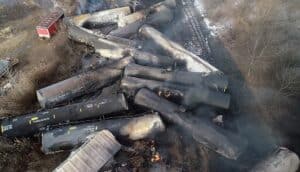The Biden administration has pledged billions in aid to Hawaii after devastating wildfires, but it has not initiated a federal investigation into the poor handling of the response. Critical issues include the non-utilization of the island’s siren system for evacuations, water supply issues during firefighting, and the promptness of federal assistance.
By contrast, in response to the train derailment in East Palestine, OH, that resulted in the release of toxic chemicals, the National Transportation Safety Board (NTSB) promptly and appropriately launched an investigation into the incident and held a two-day investigative hearing in East Palestine on June 22-23, 2023. During the hearing, the NTSB gathered sworn testimony about the Norfolk Southern Railway derailment, the subsequent hazardous material release, and the fires that followed. The testimony became part of the public record of the investigation. The NTSB also released thousands of pages of documents related to the derailment, providing a comprehensive account of the accident and the factors that led to it.

Overhead shot of smoldering derailed train cars in East Palestine, Ohio
The disparity highlights the need for a unified disaster response oversight system like a National Disaster Safety Board (NDSB). Modeled on the NTSB, a similar body tasked with investigating increasingly destructive natural disasters could bring clarity and recommendations post-crisis and shape policies to prespond to future tragedies. Lawmakers on both sides of the aisle have recognized this need, putting forth bills to formalize an NDSB.
Legislative History
The history of proposals to create a NDSB can be traced back to at least October 2020, when the Disaster Learning and Life Saving Act was first introduced. This bill sought the creation of a new, permanent and independent NDSB to study the underlying causes of disaster-related deaths and property damage across the country. It would be modeled on the NTSB and focus on improving disaster recovery systems to avoid future loss of life and major property damage.
In May 2021, Senators Brian Schatz (D-HI) and Bill Cassidy (R-LA) reintroduced the Disaster Learning and Life Saving Act in the Senate, while Representative Katie Porter (D-CA) introduced it in the House of Representatives. The bill would have created a permanent and independent board within the executive branch. The board would have the authority to investigate major disasters and emergencies which resulted in ten or more fatalities, and were non-technological in nature. The board’s mission was to investigate the “facts, circumstances, and cause or probable cause of the loss of life, human injury, and economic injury” due to the natural disaster. Based on its investigations, the NDSB would develop recommendations and best practices for improving disaster preparedness, response, and recovery efforts at all levels of government. Additionally, the act would mandate that the NDSB create an office to manage the review and recommendations of disaster mitigation. Furthermore, the office would be audited by the Government Accountability Office at least once every two years.
The National Disaster Safety Board Act of 2021 (H.R.5532) is a subsequent bill introduced by Rep. Porter in October 2021 which gave the proposed NDSB the mission to study and make recommendations concerning natural disasters. The bill created less specific mandates for the board than the Disaster Learning and Life Saving Act, but still establishes the office and provides a mandate to investigate natural disasters resulting in the loss of human life.
In July 2022, the U.S. House of Representatives passed the Wildfire Response and Drought Resiliency Act, which included a key provision for the creation of the NDSB. This provision was initially proposed by Representatives Porter, John Garamendi (D-CA), and Nancy Mace (R-SC).
Duplicating Success
Every disaster offers an opportunity – a tragic opportunity, but an opportunity nonetheless – for improvement. While simply creating another board isn’t always the answer, in this instance, the NDSB’s mandate to assess our preparedness, response, and recovery is indeed the right course of action. Even leaving aside the tragic loss of life from these disasters, the growing taxpayer and economic cost from disasters makes clear that these reviews make sense. In our recent report, Paying the Price, we attempt to quantify the rising cost of natural disasters as a result of climate change. While a topline number is difficult to precisely identify, it is abundantly clear that costs are climbing and oversight is needed. Taking cues from the successes of the NTSB, the NDSB can promote a proactive stance towards addressing climate-related challenges and enhance the nation’s climate readiness.
States and localities are ill-equipped to conduct unbiased, independent analysis of failures – or successes – in disaster preparedness, response and recovery. In many cases it will be an examination of their own failures or policies that led to the disaster impacts being greater. Texas used its commission in response to the impacts of Hurricane Harvey in 2017 to simply call for tens of billions of dollars in additional federal spending, not figure why lessons learned from 2008’s Hurricane Ike strike to the same area were not addressed. In addition, a national board can draw from a pool of national experts.
An independent board could revolutionize the way America tackles national risks spurred by climate change. The nation’s approach to disasters suffers from inadequate attention to mitigation, inadequate flood insurance coverage, poor development decisions, and historic policies that reward the powerful and politically connected and disadvantage poor and minority communities. Ultimately, the inception of the NDSB would be a strategic move towards bolstering our disaster preparedness and response – an initiative that promises not just saving lives but significant cost savings for taxpayers.










